
Photo illustration: Instagram vs Facebook Sponsored Content
Instagram Sponsored Content generates higher engagement rates with younger audiences compared to Facebook's broader demographic reach, making it ideal for visually-driven campaigns. Explore this article to understand which platform best suits your marketing strategy.
Table of Comparison
| Feature | Instagram Sponsored Content | Facebook Sponsored Content |
|---|---|---|
| Audience Reach | 1.5 billion+ monthly active users, younger demographic (18-34 years) | 2.9 billion+ monthly active users, broad demographic |
| Ad Formats | Photo, Video, Carousel, Stories, Reels | Photo, Video, Carousel, Stories, Marketplace Ads, Instant Experience |
| Engagement Rate | Higher average engagement (~1.22%) | Lower average engagement (~0.16%) |
| Targeting Options | Advanced targeting via Facebook Ads Manager: Interests, Behavior, Location | Extensive targeting: Interests, Behavior, Demographics, Connections |
| Ad Placement | Instagram Feed, Stories, Explore, Reels | Facebook Feed, Stories, Right Column, Marketplace, Video Feeds |
| Cost Per Click (CPC) | Typically higher CPC due to niche audience | Generally lower CPC due to larger audience pool |
| Best For | Brand awareness, visual storytelling, and influencer marketing | Direct response, lead generation, and community engagement |
Overview: Instagram vs Facebook Sponsored Content
Instagram and Facebook sponsored content both leverage advanced targeting options through Meta's advertising platform, allowing brands to reach specific demographics based on interests, behavior, and location. Instagram emphasizes visual storytelling with photo, video, and Stories ads optimized for mobile engagement, while Facebook offers a broader range of ad formats, including carousel, collection, and lead generation ads suited for both desktop and mobile users. Performance metrics typically indicate higher engagement rates on Instagram due to its younger user base and visual nature, whereas Facebook provides more extensive audience reach and detailed analytics for campaign optimization.
Key Differences Between Instagram and Facebook Sponsored Content
Instagram sponsored content emphasizes visual storytelling through photos and short videos, targeting younger demographics with a preference for lifestyle, fashion, and influencer-driven posts. Facebook sponsored content offers diverse ad formats, including links, events, and detailed targeting options suitable for broader age groups and various industries. Engagement on Instagram is often higher for visually appealing content, while Facebook provides robust analytics and customizable audience segmentation for precise campaign optimization.
Audience Targeting Capabilities
Social media platforms offer advanced audience targeting capabilities through demographic filters, behavioral data, and interest-based algorithms. Marketers can leverage tools like Facebook Ads Manager and LinkedIn Campaign Manager to create precise audience segments, enhancing ad relevance and ROI. Effective social media targeting increases conversion rates by delivering personalized content tailored to user preferences and online behaviors.
Ad Formats and Creative Options
Social media platforms offer a diverse range of ad formats, including image ads, video ads, carousel ads, and story ads, each designed to capture attention in unique ways. Creative options such as interactive polls, augmented reality filters, and shoppable posts enable businesses to engage your target audience effectively and drive conversions. Optimizing these formats with compelling visuals and tailored messaging enhances ad performance and maximizes return on investment.
Engagement Rates: Instagram vs Facebook
Instagram consistently outperforms Facebook in engagement rates, with average interactions per post reaching up to 1.22% compared to Facebook's 0.08%. Visual content on Instagram, including Stories and Reels, drives higher user interaction, making it crucial for brands aiming to ignite meaningful conversations. To maximize Your impact, prioritize Instagram's dynamic features that foster deeper audience engagement.
Cost and Budget Considerations
Social media marketing budgets vary widely, typically ranging from 5% to 15% of overall marketing expenses depending on industry and campaign goals. Cost factors include platform advertising rates, content creation, influencer partnerships, and management tools, with Facebook and Instagram ads averaging $0.50 to $2.00 per click. Businesses should allocate budget strategically, prioritizing high-ROI channels and regular performance analysis to optimize spend efficiency and maximize engagement.
Performance Metrics and Analytics
Performance metrics and analytics in social media provide critical insights into engagement rates, click-throughs, and conversion statistics that drive strategic decisions. By analyzing your audience's behavior and content performance through tools like Facebook Insights or Google Analytics, you can optimize campaigns for higher ROI. Tracking key indicators such as reach, impressions, and sentiment analysis ensures continuous improvement of your social media strategy.
Industry Suitability and Best Use Cases
Social media platforms vary in industry suitability, with LinkedIn excelling for B2B marketing and professional networking, while Instagram suits lifestyle, fashion, and visual-centric brands. Your business can leverage Twitter for timely customer engagement and real-time updates, making it ideal for news and tech sectors. Facebook remains versatile for e-commerce, local services, and community building, enabling targeted advertising and broad audience reach.
Choosing the Right Platform for Sponsored Content
Selecting the ideal social media platform for sponsored content depends on the target audience's demographics, engagement patterns, and the type of product or service being promoted. Instagram excels in visual storytelling and reaching younger audiences, while LinkedIn is preferred for B2B campaigns targeting professionals. Facebook offers robust targeting tools and diverse formats, making it a versatile choice for broad or niche marketing strategies.
Maximizing ROI with Platform-Specific Strategies
Maximizing ROI on social media involves tailoring strategies to each platform's unique user behavior and algorithm dynamics. Leveraging Instagram's visual storytelling, Facebook's detailed targeting, and LinkedIn's B2B networking ensures efficient budget allocation and higher engagement rates. Analyzing platform-specific analytics enables continuous optimization, driving measurable growth and enhanced return on investment.
 socmedb.com
socmedb.com